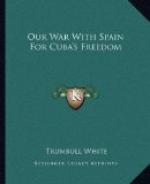According to tradition, everyone of these was once a pirate’s lair, in the good old days we read about, when “long, low, suspicious-looking craft, with raking masts,” used to steal out from sheltered coves to plunder the unwary. Each little bay, whose existence was unknown to honest mariners, has a high wooded point near its entrance, where the sea robbers kept perpetual watch for passing merchantmen and treasure-laden galleons, their own swift-sailing vessels safe out of sight within the cove; and then, at a given signal out they would dart upon the unsuspecting prey like a spider from his web. Among the most notorious piratical rendezvous was Gauntanamo, which our warships are said to have shelled two or three times of late. In recent years its narrow bay, branching far inland like a river, has become of considerable consequence, by reason of a railway which connects it with Santiago, and also because the patriot army, hidden in the nearby mountains, have entertained hopes of overcoming the Spanish garrison and making it a base for receiving outside assistance. Before the war there were extensive sugar plantations in this city, now all devastated. The Cobre mountains, looming darkly against the horizon, are the great copper and iron range of Cuba, said to contain untold mineral wealth, waiting to be developed by Yankee enterprise. In earlier days $4,000,000 a year was the average value of Cuba’s copper and iron exports; but in 1867 6,000,000 tons were taken out in less than ten months. Then Spain put her foot in it, as usual. Not content with the lion’s share, which she had always realized in exorbitant taxes on the product, she increased the excise charges to such an extent as to kill the industry outright. For a long time afterward the ore lay undisturbed in the Cobre “pockets,” until the attention of Americans was turned this way. Their first iron and copper claims in these mountains were recognized by the Cuban government about seventeen years ago. Three Yankee corporations have developed rich tracts of mining territory hereabouts, built railways from the coast to their works on the hills and exported, ore to the United States. The oldest of these companies employed 2,000 men, and had 1,600 cars and a fleet of twenty steamers for the transportation of its output. The Carnegie Company, whose product was shipped to Philadelphia, also employed upwards of a thousand men.
Santiago de Cuba.
At last an abrupt termination of the stern, gray cliffs which mark this shore line indicates the proximity of Santiago harbor, and a nearer approach reveals the most picturesque fort or castle, as well as one of the oldest, to be found on the western hemisphere. An enormous rounding rock, whose base has been hollowed into great caverns by the restless Caribbean, standing just at the entrance of the narrow channel leading into the harbor, is carried up from the water’s edge in a succession of walls, ramparts, towers and




